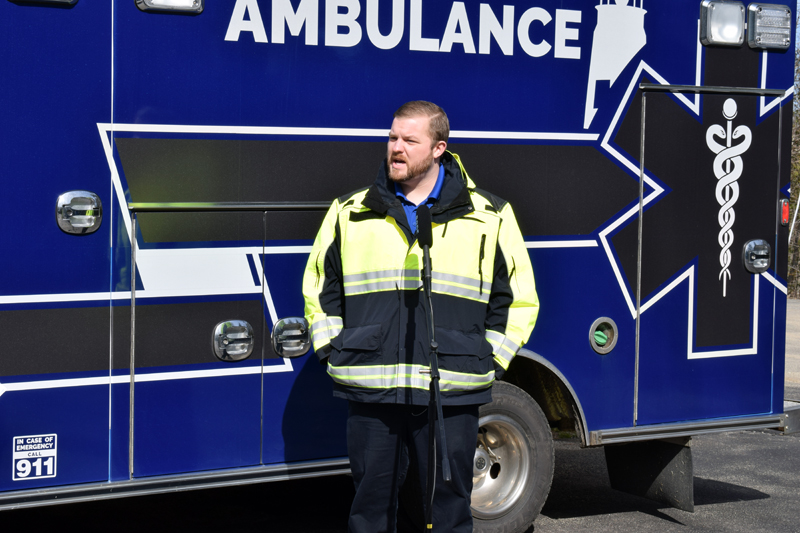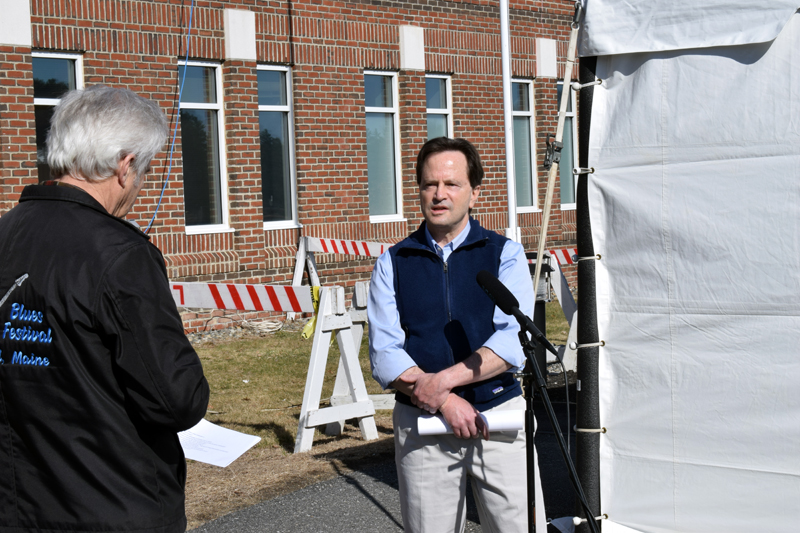
Service Chief Nick Bryant, of the Central Lincoln County Ambulance Service, provides a COVID-19 update in an interview with Lincoln County Television on Monday, April 6. (Evan Houk photo)
Although Lincoln County saw only one new case of COVID-19 over the past week, the county and the rest of Maine are preparing for a surge in hospitalizations in the coming weeks.
As of 11:45 a.m., Tuesday, April 7, Lincoln County has seen nine confirmed cases of COVID-19, the respiratory illness caused by the coronavirus. Four of the nine patients have recovered; none have been hospitalized.
The first case in Lincoln County was announced March 15. LincolnHealth announced the second, in one of its nurses, March 16. The third, fourth, and fifth case were announced March 18, 20, and 23. March 30 saw three new cases. The latest was reported Monday, April 6.
As of Tuesday, April 7, there were 519 cases of COVID-19, 99 hospitalizations, and 12 deaths in Maine. Of the 519, 176 have recovered, more than a third of all cases.
“It’s important for people in our communities to continue to practice social distancing, leave home only to pick up essential items like medication and groceries, wash their hands often, and use hand sanitizer where appropriate,” Dr. Timothy Fox, chief medical officer at LincolnHealth, said by email. “This approach appears to be working in slowing the spread of COVID-19, but the success depends on all of us doing our part.”
According to a new study by disease modelers at the University of Texas at Austin, cited in The New York Times on Friday, April 3, Lincoln County has a 93% chance of having an epidemic of COVID-19.
The study calculated probabilities of an epidemic outbreak for every county in the U.S., based on the authors’ estimate that only one out of every 10 COVID-19 cases are confirmed, due to low testing rates across the country.
The study defines an epidemic as an outbreak that grows exponentially instead of fading out on its own, eventually infecting a large fraction of the population.
Dr. Lauren Ancel Meyers, one of the study’s authors, told The New York Times that asymptomatic cases of COVID-19 and cases with mild symptoms are undetected drivers of outbreaks.
According to LincolnHealth spokesperson John Martins, LincolnHealth’s two campuses have conducted 128 COVID-19 tests, with four positives, as of Tuesday, April 7.
Martins said by email that the hospital has 241 testing kits in stock and a robust supply of personal protective equipment, such as gowns, face masks, and goggles, at LincolnHealth and across the MaineHealth system.
The hospital has been preparing for “surge capacity” over the past week and a half, shifting staff to LincolnHealth’s Miles Campus in Damariscotta, temporarily closing offices throughout the county, and setting up the triage tent in front of the emergency room at Miles.
Dr. Daniel Friedland, a primary care physician who is helping coordinate the hospital’s telemedicine program, likened the atmosphere at the hospital to an eerie “calm before the storm.” He told the LCN he hopes Lincoln County will not see a surge, but LincolnHealth is preparing for a worst-case scenario.
In an interview with Lincoln County Television on Monday, April 6, Friedland said patients only need to contact their primary care provider to set up a telemedicine visit. He said he believes most providers in Lincoln County are currently offering this service, either by phone or videoconference.

Dr. Daniel Friedland, a primary care physician who is helping coordinate LincolnHealths telemedicine program, discusses the program and COVID-19 updates in an interview with Lincoln County Television on Monday, April 6. (Evan Houk photo)
Friedland said that because of the COVID-19 crisis, most insurance companies have started to cover costs for remote telemedicine. He said the technology works well for things like annual wellness visits, follow-up visits, and behavioral health appointments.
Damariscotta-based Central Lincoln County Ambulance Service is planning for a potential surge in COVID-19 cases as well, according to Service Chief Nick Bryant.
Bryant told the LCN on Monday that he has been in talks with Damariscotta Fire Chief John Roberts about coordinating with the fire department should the ambulance service need more drivers or equipment in the event of a surge.
In an April 6 interview with LCTV, Bryant said there has been an increase in calls suspected to involve COVID-19 patients, but the overall call volume has gone down, likely due to more people staying home.
Dispatchers at Lincoln County Communications continue to ask screening questions to find out if a patient or anyone else in a residence has COVID-19 symptoms. Bryant said emergency medical services workers are then notified and can take the proper precautions when responding.
Bryant said his crew responds to suspected COVID-19 calls wearing full personal protective equipment and meets the patient outside a residence if possible. He said the ambulance service has a good stock of personal protective equipment at the moment.
State to open alternative care sites in Portland, Bangor
Gov. Janet Mills said Tuesday, April 7 that the state will set up two alternative care sites – at the Cross Insurance Arena in Portland and the Cross Insurance Center in Bangor – to help Maine’s health care system absorb a surge in COVID-19 patients.
“I hope that we never need to use these sites, but we cannot afford to wait to find out,” Mills said. “Building them now will ensure that if the need does arise, we will be prepared and Maine people will be cared for, and Maine people will survive.”
The sites will have capacity for 150 hospital beds, at least 100 in Portland and at least 50 in Bangor.
The total case number in the state, 519, represents a 71.29% increase over the 303 cases reported a week earlier, on March 31, when Mills announced a statewide “stay-at-home” order and mandated physical distancing.
On Friday, April 3, Mills ordered travelers arriving in Maine to self-quarantine for 14 days.
In his Tuesday briefing, Dr. Nirav Shah, director of the Maine Center for Disease Control and Prevention, continued to urge Mainers to practice physical distancing, stay at home as much as possible, and behave as if there is already community transmission of the coronavirus in every county. Community transmission has only been identified in Cumberland and York counties so far.
Maine CDC officials are using various complex models to plan and prepare for an inevitable surge and peak of COVID-19 cases and hospitalizations.
Shah said the one similarity across the models is that each predict that “aggressive, intensive physical distancing can reduce the spread of COVID-19 and reduce the demand on the health care system.”






